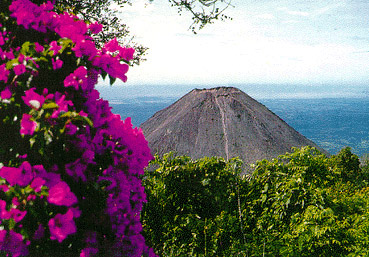|
![]()
by Liggia M. (age 14) The majesty of its mountains, rivers and lakes makes El Salvador an exotic and unique country. Its fantastic landscapes full of animals and lots of unique vegetation give El Salvador its magic touch.
El Salvador has a civilization that goes back to the pre-Colombian age, about 1,500 years B.C.; that is what some archaeological artifacts, discovered on the zone of Tazumal of Chalchuapa, show. The first to populate on El Salvador were the Pokomanes, Lencas and Chortis. They were followed by the Uluas and the Pipiles that established the western and central parts of the country in the middle of the XI century. On May 31, 1522, Spaniard Andres Niño was the commander of an expedition. He landed on the island of Meanguera in the Gulf of Fonseca. Later, he discovered the Bay of Jiquilisco, at the end of the Lempa River. He continued sailing along El Salvador's shores until he reached the Tehuantepeque near the Gulf of Mexico. The Meanguera Island was the first Salvadorean land that Spanish conquerors visited. On June 1524, the Spanish Captain Pedro de Alvarado started a war for the conquest of the Pipiles Indians on the Cuscatlán land. Seventeen days of war resulted in many Natives' deaths, even the Prince Atlacalt, chief of Cuzcatlán. Pedro de Alvarado, injured and defeated, left the battle and went to Guatemala, leaving his brother, Gonzalo de Alvarado, in charge to conquer the Cuscatlán land. Later, his cousin Diego de Alvarado, built Villa de San Salvador on April 1528 in a place called La Bermuda, near the city of Suchitoto. In 1540, San Salvador was moved to its current location, and on September 1546 received the title of city by the emperors Carlos V and Felipe II of Spain. In the years to come, the country grew with Spanish domination, and by the end of the first decade of the 19th century, there emerged in all Hispanic colonies a feeling and desire of independence and autonomy. On November 5, 1811 in San Salvador, Jose Matias Delgado said the first shout for independence. Helping give rise to the revolt of Spanish rule, he prodded on the numerous attempts for independence. With diligence, they finally succeeded and the Independence of Central America was signed in the Palace of the Captains of Guatemala on September 15, 1821. |
More information: |
||
| Explore More: Cities/Towns: |

 Welcome to El Salvador
Welcome to El Salvador 